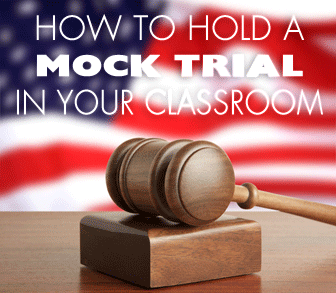True, not many of your students will have to stand up in court and defend themselves or prosecute another in the English language, though a few may, but that is no reason to dismiss having a mock trial in your classroom.
A mock trial has more to offer your students than familiarity with court procedures. Playing roles in a mock trial requires your students to speak clearly, logically and with conviction. They will need and develop confidence in their speaking abilities as they play formal roles in a mock court setting. So even if you and your students are not pre-law, give a mock trial a chance in your ESL classroom and you may find that your students’ language abilities flourish, case closed!
How to Hold a Mock Trial in Your Classroom
-
1
Give a Briefing
Because your students may not be familiar with U.S. legal proceedings, start by showing them this short video on the Supreme Court from pbs.org. It gives a general idea of the purpose of the Supreme Court, and PBS has also supplied a transcript and comprehension questions that you may choose to use with your students. Point out that the courts in the U.S. are not designed to create the law but to apply the laws that already exist. You should also give your students a chance to ask any questions they may have about the U.S. legal system.
-
2
Assign Roles
Tell your students that they are going to hold a mock trial in the classroom. You may need to explain what this term means. Once you do, you can assign roles to your students. Start by asking your students what roles they think people might play in court proceedings. If your students would benefit from seeing a trial in progress, you may want to show clips from A Few Good Men, 12 Angry Men, or even old episodes of Night Court. Your students may not know the correct terminology for each position, but they should be able to get a feel for what each person is doing. You also have the option of having your class read a scripted trial in class, though this may be a greater time investment than you want to take. Review the specific roles that various people play in the trial and give their official titles. Give accurate vocabulary (defendant, prosecutor, judge, attorney, witness) for the different roles as well as an explanation of what each person does during the trial. Have students choose roles or assign them as you see fit, but make sure each person will have a speaking part in the trial.
-
3
Review the Steps
Now that your students understand the roles and know which they will be playing, review with them the steps in the trial.
- The Prosecutor’s Statement
- The Defendant’s Statement
- The Prosecutor Calls Witnesses (and defendants have an opportunity to cross-examine)
- The Defense Calls Witnesses (and prosecution has an opportunity to cross examine)
- The Prosecutor’s Closing Statement
- The Defendant’s Closing Statement
- Deliberation of the Jury
- The Verdict
As you review each of these steps, point out who does the majority of the speaking for each.
-
4
Prepare and Play Out
Before the actual mock trial, give your students time to prepare. The prosecution and defense will be doing the most work at this point. They will want to interview witnesses and prepare their opening and closing statements. They may even do some legal research, but that is completely optional. Keeping the topic of the trial lighthearted will keep the element of fun in an otherwise serious situation. You may want to try Goldilocks vs. the Three Bears or The Three Little Pigs vs. The Big Bad Wolf. If your students are more suited to a serious topic, choose something more realistic, or tie the topic into material you are already working with in class. You may decide to use a situation your students have read about in a piece of literature, the newspaper or a controversial issue you discussed in class.
When the day of the trial arrives, act as director or even as judge as the students play their parts. After everyone has spoken, have the jury deliberate privately. They will get the most speaking practice during this deliberation, so make sure they have enough time and that they discuss all of the important elements of the trial and review all the evidence. The judge closes the trial by announcing the verdict.
-
5
Extend
After the great accomplishment your students have made, celebrate with a court themed movie and a classroom party, but your court ties do not have to end there. You can extend the activity further in ways that will continue to challenge and develop your students’ language skills. Many courthouses are open to the public, and your ESL class may enjoy a field trip to see an actual trial in process. Another option is to invite a law professional to come to your class and give a presentation. Allow your students enough time to ask about actual court proceedings and share their own experiences in the mock trial as well.
If you decide to give your ESL students the opportunity to participate in a mock trial, you will see the confidence that develops from public speaking and logical argument.
They will have experience in presenting as well as interviewing and deliberating, all valuable language skills. A mock trial may not be the best fit for every ESL class, but those that take the chance will find that it was a meaningful and memorable experience for your students!
P.S. If you enjoyed this article, please help spread it by clicking one of those sharing buttons below. And if you are interested in more, you should follow our Facebook page where we share more about creative, non-boring ways to teach English.








